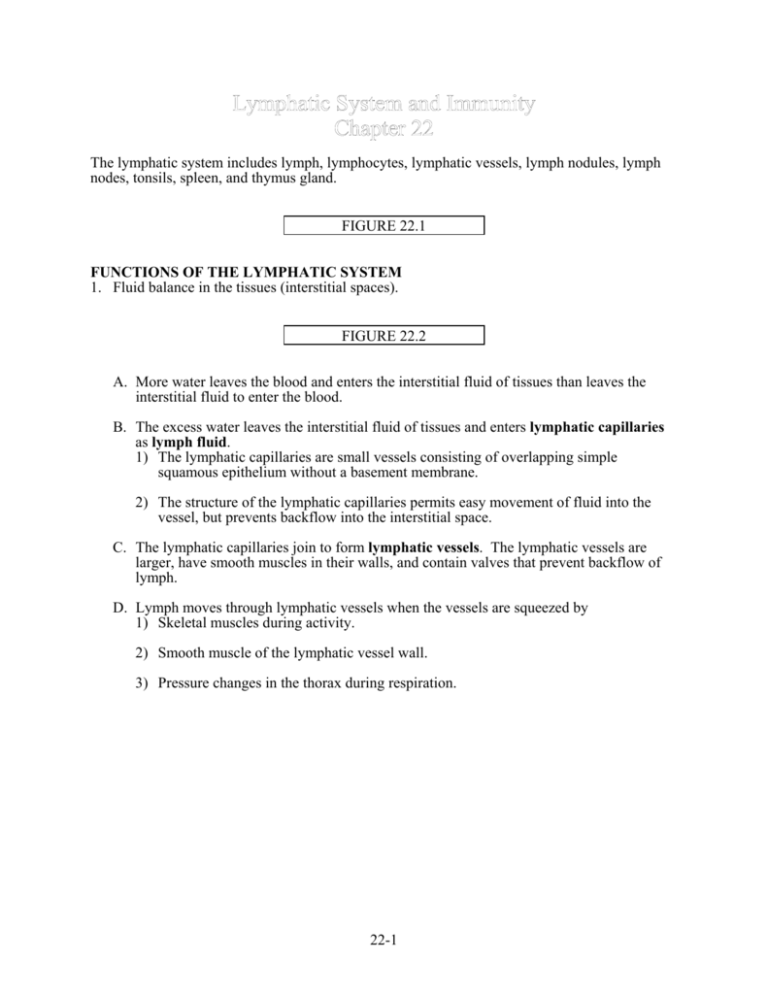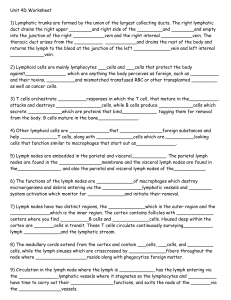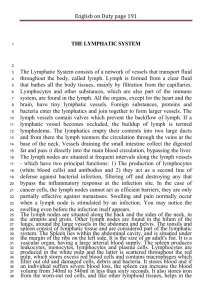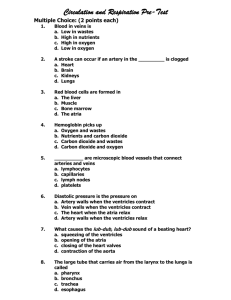22-1 The lymphatic system includes lymph, lymphocytes, lymphatic
advertisement

The lymphatic system includes lymph, lymphocytes, lymphatic vessels, lymph nodules, lymph nodes, tonsils, spleen, and thymus gland. FIGURE 22.1 FUNCTIONS OF THE LYMPHATIC SYSTEM 1. Fluid balance in the tissues (interstitial spaces). FIGURE 22.2 A. More water leaves the blood and enters the interstitial fluid of tissues than leaves the interstitial fluid to enter the blood. B. The excess water leaves the interstitial fluid of tissues and enters lymphatic capillaries as lymph fluid. 1) The lymphatic capillaries are small vessels consisting of overlapping simple squamous epithelium without a basement membrane. 2) The structure of the lymphatic capillaries permits easy movement of fluid into the vessel, but prevents backflow into the interstitial space. C. The lymphatic capillaries join to form lymphatic vessels. The lymphatic vessels are larger, have smooth muscles in their walls, and contain valves that prevent backflow of lymph. D. Lymph moves through lymphatic vessels when the vessels are squeezed by 1) Skeletal muscles during activity. 2) Smooth muscle of the lymphatic vessel wall. 3) Pressure changes in the thorax during respiration. 22-1 E. The lymphatic vessels eventually converge and empty into the blood. FIGURE 22.3 1) Lymphatic vessels converge to form larger lymphatic trunks, which empty into veins. Lymphatic trunks from the right thorax, right upper limb, and right side of the face and neck connect to the junction of the internal jugular vein and subclavian vein or nearby veins. About 20% of the time the lymphatic trunks join to form a short duct called the right lymphatic duct. 2) The rest of the body is drained through lymphatic trunks and vessels that empty into the thoracic duct, which connects to the junction of the internal jugular vein and subclavian vein. 2. Fat absorption. A. Fats absorbed from the small intestine are packaged into chylomicrons. The chylomicrons enter lacteals (lymphatic capillaries) in the villi. Lymph with fat has a milky appearance and is called chyle (Gr. juice). B. The structure of the lacteals allows the large chylomicrons to enter the lacteal. The blood capillaries in the villi are typical epithelium (i.e., have a basement membrane with cells that are tightly joined) that does not allow the chylomicrons to enter the blood capillaries. C. Lymph from the lymphatic capillaries eventually drains into the inferior end of the thoracic duct, the cisterna chyli. D. The thoracic duct carries the chyle to the blood. 3. Defense. The lymphatic system filters lymph and blood to remove and destroy microorganisms, other foreign substances, and defective red blood cells. LYMPHATIC ORGANS 1. Lymphatic tissue is reticular connective tissue containing immune cells. Reticular fiber Macrophage Lymphocyte Foreign substance A. The reticular fibers, which are produced by reticular cells, from a network that holds the cells in place and also functions to trap microorganisms. B. The immune cells are white blood cells, such as lymphocytes, or cells derived from white blood cells, such as macrophages. 22-2 2. As interstitial fluid, lymph, or blood is filtered through the lymphatic tissue, the lymphocytes and macrophages can respond to any foreign substances found. The response usually leads to the destruction of the foreign substance. 3. Lymphatic tissue is found as diffuse lymphatic tissue and is found in lymph nodules, lymph nodes, the tonsils, Peyer's patches, the spleen, and the thymus. Diffuse Lymphatic Tissue and Lymphatic Nodules FIGURE 22.4 1. Diffuse lymphatic tissue has no clear boundary and blends in with surrounding tissues. It is found under mucous membranes, around lymph nodules, and within the lymph nodes and spleen. 2. Lymphatic nodules are a denser arrangement of lymphatic tissue into a spherical-shaped structure. A. Lymphatic nodules are found in the loose connective tissue (just below the epithelium) of the digestive, respiratory, and urinary tracts. B. Peyer's patches are aggregations of lymphatic nodules found in the lower half of the small intestine and the appendix. Tonsils FIGURE 22.5 1. Tonsils are aggregations of lymphatic nodules beneath the mucous membranes of the oral cavity and nasopharynx (back part of the throat that is connected to the nasal cavity). There are three sets of tonsils. A. The palatine tonsils ("the tonsils") are found on each side of the posterior oral cavity. B. The pharyngeal tonsil is located in the nasopharynx. A swollen pharyngeal tonsil is commonly referred to as an adenoid (or the adenoids). Swelling of this tissue can cause difficulty in breathing. C. The lingual tonsil is found in the base of the tongue. D. The tonsils may be removed if they become chronically infected. The lingual tonsils are difficult to remove. E. In adults, the tonsils decrease in size and may disappear. 22-3 Lymph Nodes FIGURE 22.6 1. Lymph nodes are found along lymphatic vessels. There are approximately 400-500 lymph nodes in the human body. 2. Lymph nodes can be subdivided into superficial and deep lymph nodes. Large aggregations of superficial lymph nodes are found in the groin, axillae (armpits), and neck. 3. Lymph nodes function to filter lymph before it returns to the blood. 4. Structure. A. The outer part of lymph nodes is a connective tissue capsule. Extensions of the capsule into the lymph node, called trabeculae, subdivide the interior of the lymph node. B. Reticular fibers extend between the trabeculae to form a network of fibers. 1) Lymphatic tissue is reticular fibers packed with cells. 2) A lymph sinus is space within a lymph node. The lymph sinus has reticular fibers and is filled with lymph. C. The lymph node can be divided into a cortex and medulla. 1) The cortex (outer part) contains lymphatic nodules. 2) The medulla (inner part) consists of medullary cords, which are irregular strands of lymphatic tissue separated by lymph sinuses. D. Lymph filters through the lymph node. 1) Afferent lymphatic vessels enter the lymph node and a lesser number of efferent lymphatic vessels exit the lymph node. Lymph nodes are the only structures that have both afferent and efferent lymphatic vessels. 2) Lymph filters through the lymphatic sinuses and lymphatic tissue. Foreign substances are removed and lymphocytes are activated. A lymph nodule containing active, replicating lymphocytes is called a germinal center. 3) Lymphocytes are carried out of lymph nodes in the lymph. They enter the blood and circulate to other lymphatic organs, including other lymph nodes. During radical cancer surgery, lymph nodes in the tissue surrounding the cancerous tumor are removed, and their lymphatic vessels are tied off. Explain the rationale for removing the lymph nodes. What is likely to happen as a result of tying off the lymphatic vessels? 22-4 Spleen FIGURE 22.7 1. The spleen is roughly the size of a clenched fist, and it is located in the left, superior, posterior corner of the abdominal cavity. 2. The spleen functions to filter blood. It responds to foreign substances, such as bacteria, in the blood and removes damaged red blood cells from the blood. The spleen also holds a small amount of blood (30 to 40 ml) that can be released from the spleen. Thus, the spleen serves a modest function as a blood reservoir. Blood can be released during exercise and to help compensate for blood loss. 3. Structure. A. The outer part of the spleen is a connective tissue capsule. Extensions of the capsule into the spleen, called trabeculae, subdivide the interior of the spleen. B. Reticular fibers extend between the trabeculae to form a network of fibers. C. The spleen has two types of lymphatic tissue that filter the blood. 1) The white pulp surrounds arteries and functions to detect and respond to foreign substances. The white pulp forms the periarterial sheath (diffuse lymphatic tissue around the arteries) and lymphatic nodules (usually off to the side of an artery). 2) The red pulp consists of the splenic cords, which are a network of reticular cells and fibers containing red blood cells and macrophages, and the venous sinuses, which are enlarged capillaries between the splenic cords. The red pulp is specialized to perform phagocytosis of foreign substances and damaged, worn out red blood cells. 3) Blood enters the spleen through arteries. Branches of the arteries pass through the white pulp. The blood leaves the arterial branches and passes into the red pulp and into the venous sinuses. The venous sinuses drain into veins that carry blood out of the spleen. 4) When the spleen is lacerated or ruptured, bleeding from the red pulp is difficult to stop. A splenectomy removes the spleen and ties off the major blood vessels to the spleen. As a result of injury suffered during an auto accident, a patient has her spleen removed. Her doctor tells her that at the first sign of a respiratory infection she should start taking antibiotics. Explain. 22-5 Thymus FIGURE 22.8 1. They thymus is a bilobed gland located in the superior mediastinum (partition dividing the thoracic cavity into left and right parts). 2. The thymus weighs approximately 10-15g at birth and increases in weight to approximately 20g by one year of age. Thereafter, it stays the same size until 60 years of age, after which it gradually decreases in size and may become quite small. By 40 years of age much of the thymus is fat tissue. 3. The function of the thymus is to produce lymphocytes (T cells) that leave the thymus and are carried by the blood to other lymphatic organs. In these locations, the lymphocytes respond to foreign substances. 4. Structure. A. The outer part of the thymus is a connective tissue capsule. Extensions of the capsule into the thymus, called trabeculae, subdivide the thymus into lobules. B. The lobules are divided into an outer cortex and an inner medulla. 1) Large numbers of lymphocytes are produced in the cortex. Most of them die, but some migrate to the medulla and enter the blood. 2) The cells of the thymus are separated from the blood by a blood-thymic barrier. This barrier is formed by reticular cells and it keeps large molecules from entering the thymus. Thus, the thymus does not respond to foreign substances in the blood. Instead, the thymus functions as a source of lymphocytes (T cells) for other lymphatic tissue. 22-6 Summary Diagram 22-7








